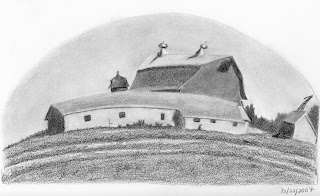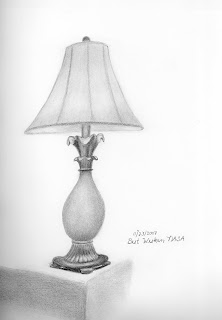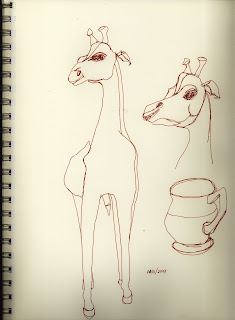
What did I accomplish in 2007?
I started using the Internet and my computer for art. I now use a scanner, a digital camera, and Photoshop Elements as art tools. From January through May, I participated regularly in the WetCanvas Weekly Drawing Challenges and in the WetCanvas Scavenger Hunts. The focus of the Weekly Drawing Challenge is to draw from a photograph, and the focus of the Scavenger Hunt is to draw from life. In September, I started a blog so I could participate in the Illustration Friday (IF) and Everyday Matters (EDM) group.
My overall 2007 goal was to be more creative and open to experimentation. I am happy with my progress. I started out 2007 copying photographs and objects from life, and I ended 2007 rarely copying. I credit Dodson's Keys to Drawing With Imagination with helping me to use my imagination. Before doing the exercises in his book, I never drew from imagination. Now I am very comfortable doing so.
IF has also helped me tap into my creativity. The IF weekly prompt is very open-ended and enables me to be creative on a weekly basis. Outstanding artists participate in IF, and viewing their work is very motivating and inspiring. IF also shows me what I don't know. For example, for one prompt, I wanted to draw a barbaric horde. I quickly realized I hadn't the foggiest idea of how to draw a horde. I am learning that illustration requires excellent drawing skills. Drawing from life and studying masters is useful for representational illustration. For example, Goya excelled at drawing and painting masses of people; his techniques may be applicable to barbaric hordes.
There are also many excellent artists in the EDM group. I am inspired every time I look at the EDM Superblog.
I wish I had painted and used color more in 2007. Working full time, occasional work travel, and two children make painting a challenge. I can sit with my kids in the living room and draw in the evenings, but can't sit with them and paint, due to the mess. I can draw in a hotel room, but not paint. Maybe I need to look into a small travel set of paints and try them out.
- Keys to Drawing With Imagination by Bert Dodson (Chapters 1-3).
- Design: Principles and Problems by Paul Zelanski and Mary Pat Fisher (Chapters 1-4).
- Art of Still Life Drawing by Sterling Publishing Co. (I skipped around).
- Pastel Workbook by Jackie Simmonds (All chapters).
I took an oil painting class offered by a Continuing Ed program.
I used pencil, pen and ink, charcoal, pastels, oils, watercolors, and collage in my art work.
















































